Special Report
Largest Industry in Each State

Published:
Last Updated:

One of the strengths of the United States is its diverse economy, which comprises many industries that contribute to overall economic development and greater stability. Total U.S. economic output topped $16 trillion in 2015, and each state’s contribution to overall GDP was unique, both in terms of size and industrial composition.
For example, California, New York, and Texas each generated over $1 trillion in economic output in 2015. Combined, these three states accounted for 31% of the nation’s total economic output. Each state’s unique economic landscape is shaped by a range of factors, from legal regulations to the presence natural resources. For example, with the nation’s largest oil reserves, oil and gas extraction drives Texas’s economy. Meanwhile, since removing certain banking restrictions, credit intermediation drives the South Dakota economy
Real estate is by far the largest industry in the United States and the largest contributor to GDP in most states. But since housing is a universal need irrespective of geography, it fails to illuminate regional economic differences. In order to capture the unique economic features of each state, 24/7 Wall St. reviewed the largest industry in each state by GDP contribution — excluding real estate.
Click here to see the largest industry in each state.
Click here to see our detailed findings and methodology.
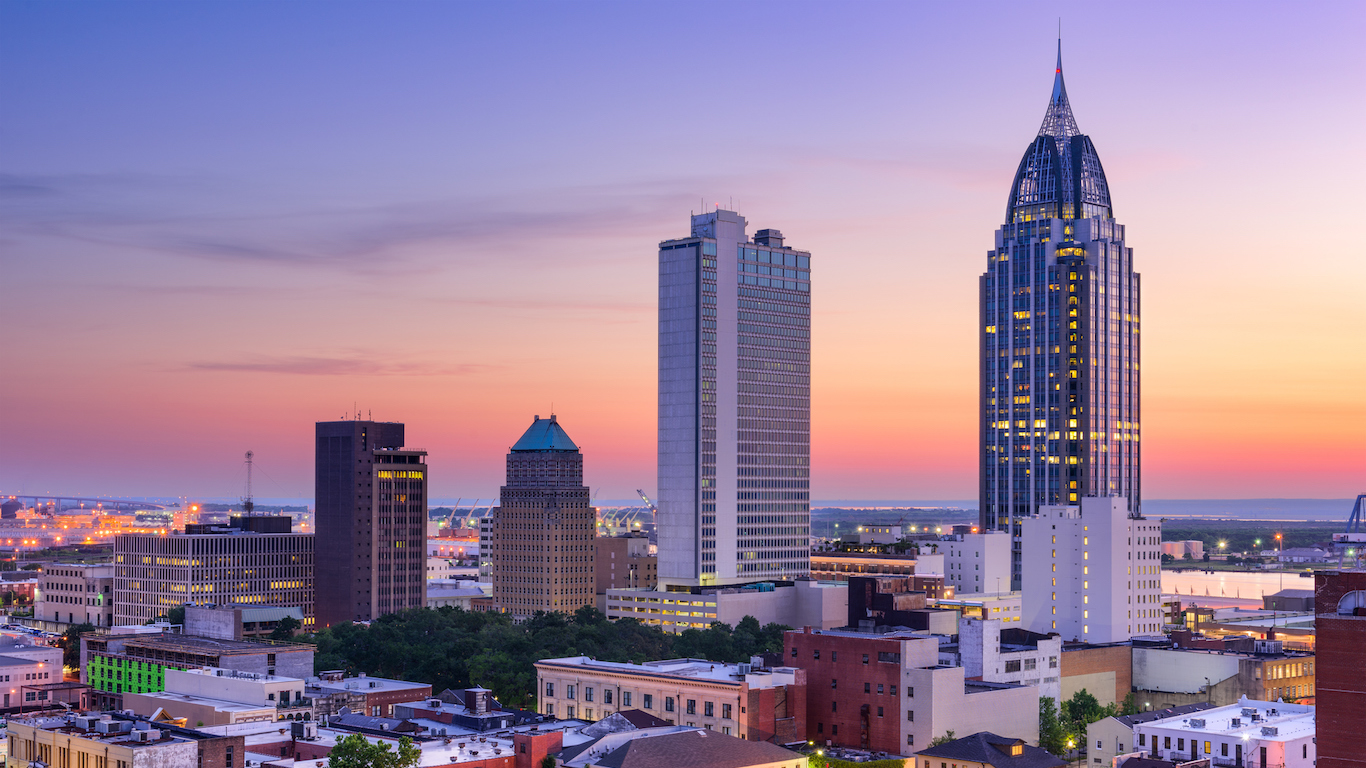
1. Alabama
> Largest industry: Ambulatory health care services
> Industry GDP contribution: $8.0 billion
> Industry output as pct. of GDP: 4.5%
> Industry workforce: 180,952
Ambulatory health care services counted for about $8.0 billion in economic output in Alabama in 2015, more than any other industry. Those with chronic conditions are more likely to use outpatient care services such as physical therapy, and in Alabama, an estimated 8.4% of state residents aged 18-64 are on disability, the second highest share of any state.
[in-text-ad]
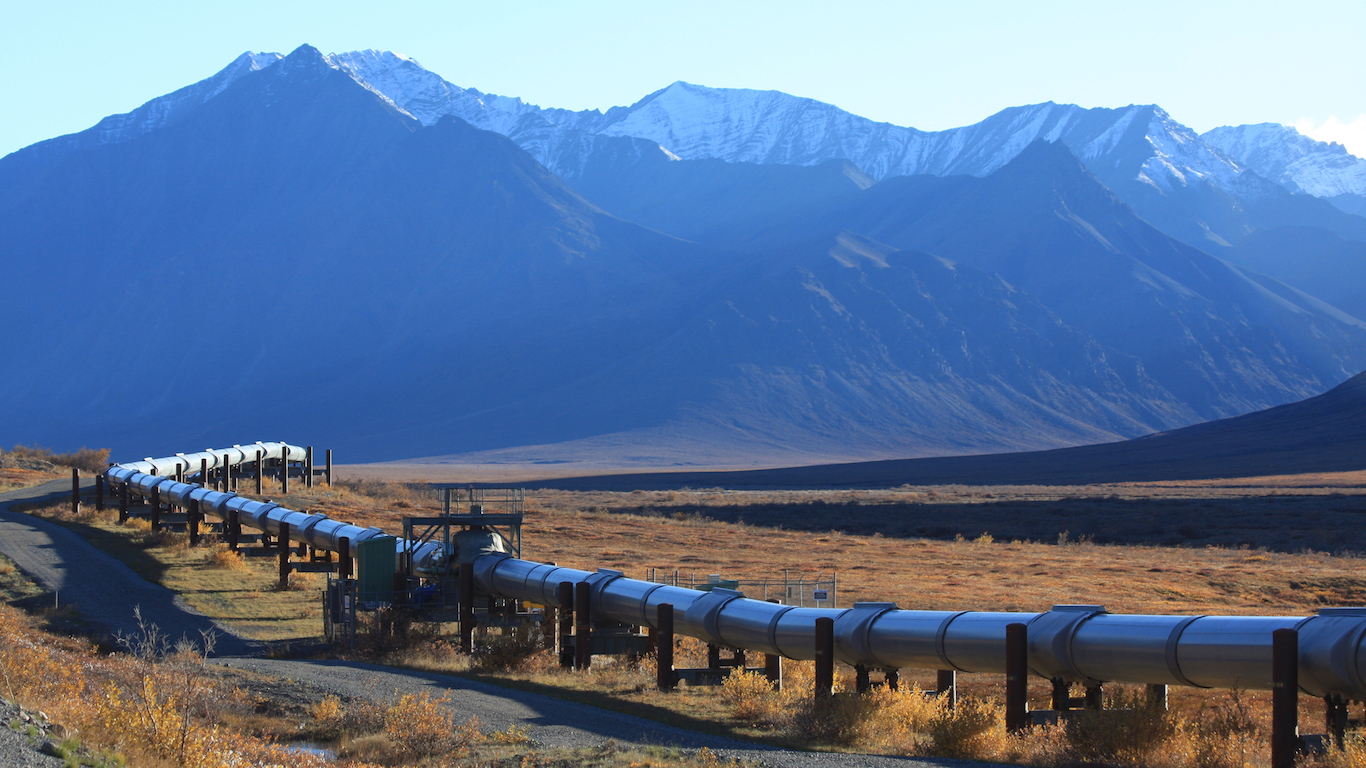
2. Alaska
> Largest industry: Oil and gas extraction
> Industry GDP contribution: $9.8 billion
> Industry output as pct. of GDP: 19.6%
> Industry workforce: 4,091
Home to the Prudhoe Bay oil field, one of the largest of its kind in the nation, Alaska’s economy is heavily dependent on natural resource extraction. Like other oil-producing states, Alaska’s economy took a hit when oil prices plummeted in 2014. Though oil and gas extraction remains the largest industry in the state, the industry contributed only $9.8 billion to GDP in 2015, down 9.4% from five years prior. Tumbling oil prices are largely to blame for the 2.1% state economic contraction over that period.

3. Arizona
> Largest industry: Ambulatory health care services
> Industry GDP contribution: $12.5 billion
> Industry output as pct. of GDP: 4.8%
> Industry workforce: 291,764
Accounting for $12.5 billion in economic activity, ambulatory health care, which includes services provided by clinics and doctors offices, is the largest industry in Arizona. Economic output generated by outpatient health care services expanded by 5.4% from 2014 to 2015. The elderly typically require more frequent medical care than younger people, and some 16.4% of Arizona residents are 65 or older — one of the larger shares of all states.

4. Arkansas
> Largest industry: Ambulatory health care services
> Industry GDP contribution: $4.3 billion
> Industry output as pct. of GDP: 4.0%
> Industry workforce: 102,340
Ambulatory health care services — such as those provided at dentists, doctors offices and diagnostic laboratories — generated $4.3 billion in economic output in Arkansas in 2015, more than any other industry. However, Arkansas is less dependent on its largest largest industry than the vast majority of states. Arkansas’ largest industry accounts for 4.0% of state GDP. In the vast majority of states, the largest industry accounts for at least 5.0% of total GDP.
[in-text-ad-2]
5. California
> Largest industry: Computers and electronics manufacturing
> Industry GDP contribution: $93.1 billion
> Industry output as pct. of GDP: 4.2%
> Industry workforce: 264,698
California has several major industries that are large enough to dominate the economy of many other states. This includes farms, an $18.7 billion industry in the state, and motion pictures, which produce more than $50 billion annually for the state. Both of these pale in comparison to the state’s computers and electronics segment, the epicenter of which is the state’s famous Silicon Valley. The sector employs 265,000 Californians, roughly equivalent to the entire workforce of Wyoming.

6. Colorado
> Largest industry: Oil and gas extraction
> Industry GDP contribution: $12.7 billion
> Industry output as pct. of GDP: 4.4%
> Industry workforce: 10,287
While many might not immediately associate Colorado with oil and gas extraction, the industry was the state’s largest in 2015, and a boon to its economy. The industry’s total economic output totalled $12.7 billion, up 24.8% from the previous year and 92.2% from five years earlier. Due in part to the industry’s robust growth, Colorado’s GDP climbed 3% in 2015, more than the vast majority of states.
[in-text-ad]

7. Connecticut
> Largest industry: Insurance
> Industry GDP contribution: $16.2 billion
> Industry output as pct. of GDP: 7.1%
> Industry workforce: 57,031
Though Connecticut’s economic output accounts for only about 1.4% of total U.S. GDP, the state’s insurance industry accounts for a disproportionate 3.6% share of all insurance activity nationwide. Indeed, the state capital of Hartford is also commonly referred to as the insurance capital of the world. Though the state’s insurance industry expanded by a healthy 4.5% in 2015, the industry may not continue to be a boon for the state’s economy for long. Earlier this year, insurance giant Aetna, which was founded in Hartford over 150 years ago, announced plans to move its headquarters out of the city.

8. Delaware
> Largest industry: Insurance
> Industry GDP contribution: $8.5 billion
> Industry output as pct. of GDP: 14.1%
> Industry workforce: 6,250
Delaware’s insurance industry is the third biggest employer in the state and the largest contributor to state GDP, generating $8.5 billion in economic output in 2015. The state’s insurance industry has expanded a great deal in the last few years, with total output expanding by more than 25% over the past five years. In 2011, the industry contributed $6.7 billion to state GDP.

9. Florida
> Largest industry: Ambulatory health care services
> Industry GDP contribution: $39.3 billion
> Industry output as pct. of GDP: 5.0%
> Industry workforce: 908,148
The elderly typically require more frequent medical care than younger people, and 19.5% of Floridians are 65 and older — the largest share of any state. The relatively large elderly population in the Sunshine State bolsters the $39.3 billion outpatient health care industry. Ambulatory health care services expanded by 7.9% in 2015, driving the 3.6% state GDP growth in Florida.
[in-text-ad-2]

10. Georgia
> Largest industry: Broadcasting and telecommunications
> Industry GDP contribution: $25.3 billion
> Industry output as pct. of GDP: 5.7%
> Industry workforce: 58,243
Most people reasonably think of Hollywood or perhaps New York City as the largest centers of film and television production in the United States. However, Atlanta, Georgia has seen explosive growth in the industry in recent years. Between 2008 and 2015, over 140 movies and television shows were filmed in the area. This trend kicked off in 2008, when the state began offering a 20% tax discount to large productions. The state’s economic focus is not limited to feature length films. Georgia’s broadcasting and telecommunications industry is its largest, contributing $25.3 billion to the state’s total GDP.

11. Hawaii
> Largest industry: Accommodation
> Industry GDP contribution: $3.8 billion
> Industry output as pct. of GDP: 5.3%
> Industry workforce: 78,342
Hawaii’s economy is highly dependent on tourism. In 2015, a record 8.7 million visitors contributed significantly to the accommodations industry’s $3.8 billion in economic output that year. This was the largest contribution to state GDP, accounting for 5.3% of Hawaii’s GDP. Though Hawaii’s economic output accounts for only half a percentage point of total U.S. GDP, its accommodation industry accounts for a disproportionately high 2.9% of the industry’s nationwide output.
[in-text-ad]

12. Idaho
> Largest industry: Computers and electronics manufacturing
> Industry GDP contribution: $2.5 billion
> Industry output as pct. of GDP: 4.2%
> Industry workforce: 11,885
While some might think agriculture would be the largest industry in Idaho given its famed Idaho potatoes, the computers and electronics components manufacturing industry is actually the largest. This is largely due to the presence of massive semiconductor company Micron, which is based in Boise and was actually financed by potato farmer J.R. Simplot. Still, Idaho is somewhat less dependent on its largest industry than most states as the industry accounted for just 4.2% of GDP, one of the smaller shares compared to the largest industries in other states.

13. Illinois
> Largest industry: Insurance
> Industry GDP contribution: $31.3 billion
> Industry output as pct. of GDP: 4.6%
> Industry workforce: 112,372
With $31.3 billion in economic output in 2015, Illinois’ insurance industry is larger than Vermont’s entire economy. The state is home to a number of insurance giants, including Allstate, State Farm, and Blue Cross Blue Shield. The state’s insurance industry expanded by 3.7% in 2015, outpacing Illinois’ 1.0% overall GDP growth that year.
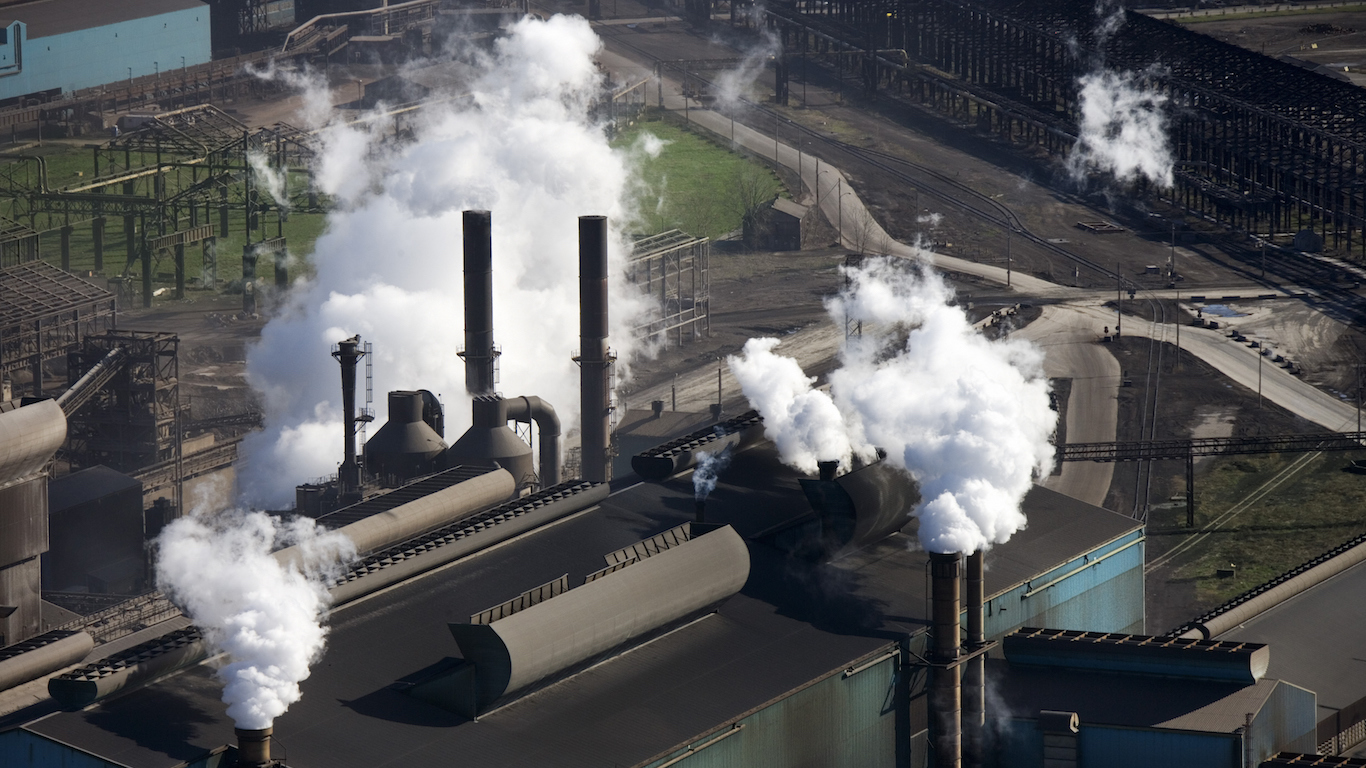
14. Indiana
> Largest industry: Chemical products manufacturing
> Industry GDP contribution: $21.3 billion
> Industry output as pct. of GDP: 7.2%
> Industry workforce: 30,957
The chemical products manufacturing subsector includes pharmaceutical and medicine manufacturing, and Indiana is home to several drug companies, including Eli Lilly, one of the largest drug makers in the United States. Chemical products manufacturing employs over a quarter of a million people in the state and accounts for 7.2% of its total GDP.
[in-text-ad-2]

15. Iowa
> Largest industry: Insurance
> Industry GDP contribution: $14.3 billion
> Industry output as pct. of GDP: 9.1%
> Industry workforce: 42,603
While Connecticut’s capital, Hartford, is sometimes referred to as the insurance capital of the world, another state capital also serves as a major center of operations for the industry. Iowa’s capital of Des Moines has more than 80 separate insurance agencies operating in the city. On the whole, Iowa’s insurance industry employs more than 42,000 people and contributes over $14 billion to the state’s economy, or over 9% of total state GDP. The industry is also on the rise, having increased by 13.7% in 2015.

16. Kansas
> Largest industry: Ambulatory health care services
> Industry GDP contribution: $4.8 billion
> Industry output as pct. of GDP: 3.5%
> Industry workforce: 110,678
Producing one-fifth of the country’s wheat, Kansas might be best known for its agricultural production, but agriculture is not its largest industry. The state’s outpatient health care industry is larger. While Kansas farms in 2015 accounted for about $3.5 billion in GDP, the state’s ambulatory health care services accounted for $4.8 billion. A boon for Kansas’s economy, the industry grew by 6.3% in 2015, much faster than the state’s overall 2.2% GDP growth that year.
[in-text-ad]
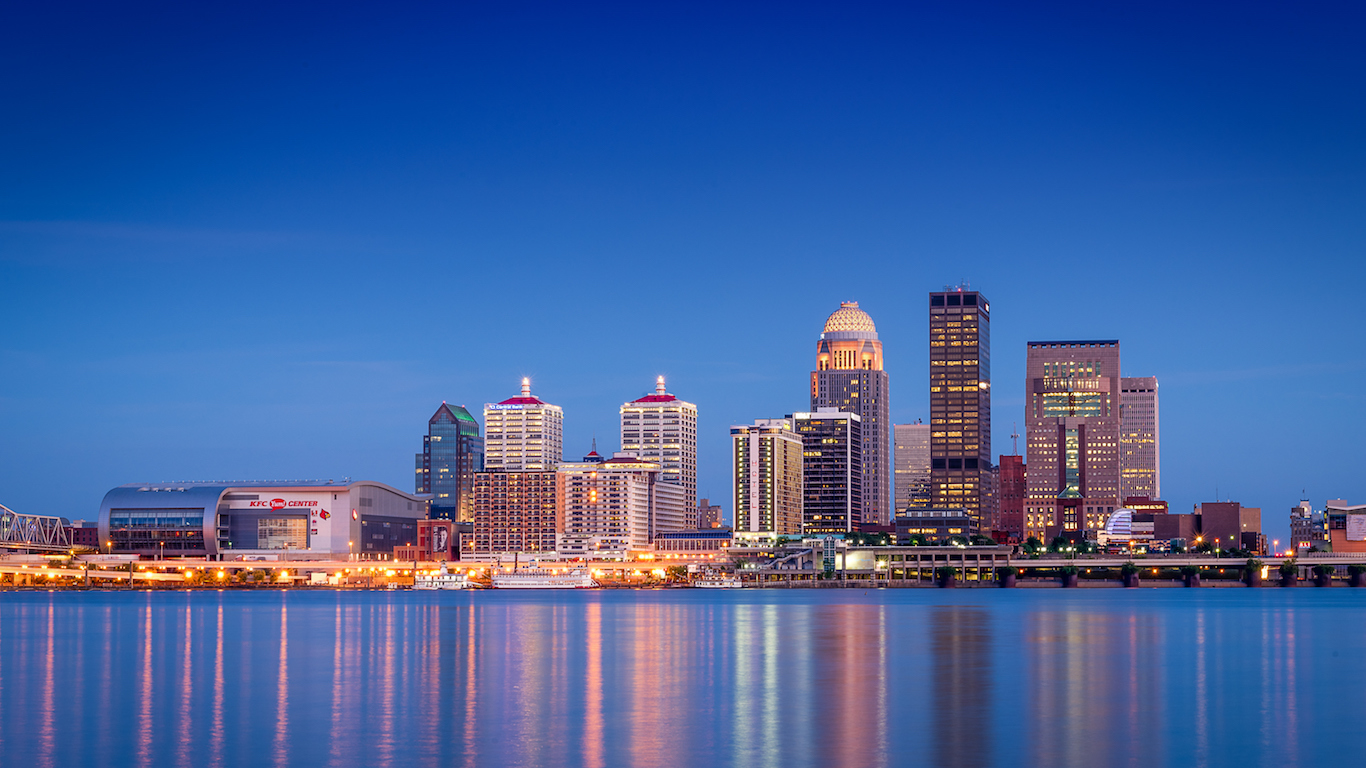
17. Kentucky
> Largest industry: Ambulatory health care services
> Industry GDP contribution: $6.9 billion
> Industry output as pct. of GDP: 4.0%
> Industry workforce: 163,166
Ambulatory health care services contributed $6.9 billion to Kentucky’s economy in 2015. People facing chronic illnesses and other health conditions are more likely to access outpatient care. In Kentucky, 17% of the total population received disability benefits, the third highest share in the country. Though health care is it the state’s largest industry, Kentucky is not overly dependent on it. Ambulatory services accounted for only 4.0% of the state’s total GDP. In most states, the largest industry accounts for at least 5.0% of total economic output.

18. Louisiana
> Largest industry: Petroleum and coal products manufacturing
> Industry GDP contribution: $15.7 billion
> Industry output as pct. of GDP: 7.6%
> Industry workforce: 12,060
One of the biggest energy producers, Louisiana’s 18 oil refineries are capable of processing over 3.3 million barrels of crude oil a day. The state’s petroleum and coal products manufacturing industry generated $15.7 billion in 2015. While falling oil prices have hurt many states that depend on oil extraction, Louisiana’s largest industry appears to be thriving. The state’s petroleum and coal products manufacturing industry expanded by 11.8% in 2015.

19. Maine
> Largest industry: Hospitals and nursing and residential care facilities
> Industry GDP contribution: $3.4 billion
> Industry output as pct. of GDP: 6.6%
> Industry workforce: 169,380
The typical Maine resident is about 45-years old, the highest median age of all states and well above the 38 year median age nationwide. Additionally, 18.8% of state residents are 65 or older, the largest share of any U.S. state after only Florida. The state’s relatively large elderly population partially explains why the state’s largest industry — with an output of $3.4 billion — is hospitals and nursing and residential care facilities.
[in-text-ad-2]

20. Maryland
> Largest industry: Ambulatory health care services
> Industry GDP contribution: $12.4 billion
> Industry output as pct. of GDP: 3.8%
> Industry workforce: 264,430
Generating $12.4 billion in economic output in 2015, ambulatory health care services is the largest industry in Maryland. The industry, which includes outpatient facilities and doctors offices, accounts for 3.8% of the state’s total GDP. Baltimore’s Johns Hopkins University is home to both one of the most respected hospitals and medical schools in the country.

21. Massachusetts
> Largest industry: Hospitals and nursing and residential care facilities
> Industry GDP contribution: $20.0 billion
> Industry output as pct. of GDP: 4.6%
> Industry workforce: 880,755
Hospitals and nursing facilities generated nearly $20 billion in Massachusetts in 2015. People come from around the country to the state for its medical facilities and educational institutions. Both Harvard’s medical school and Massachusetts General Hospital rank among the best in the United States.
[in-text-ad]
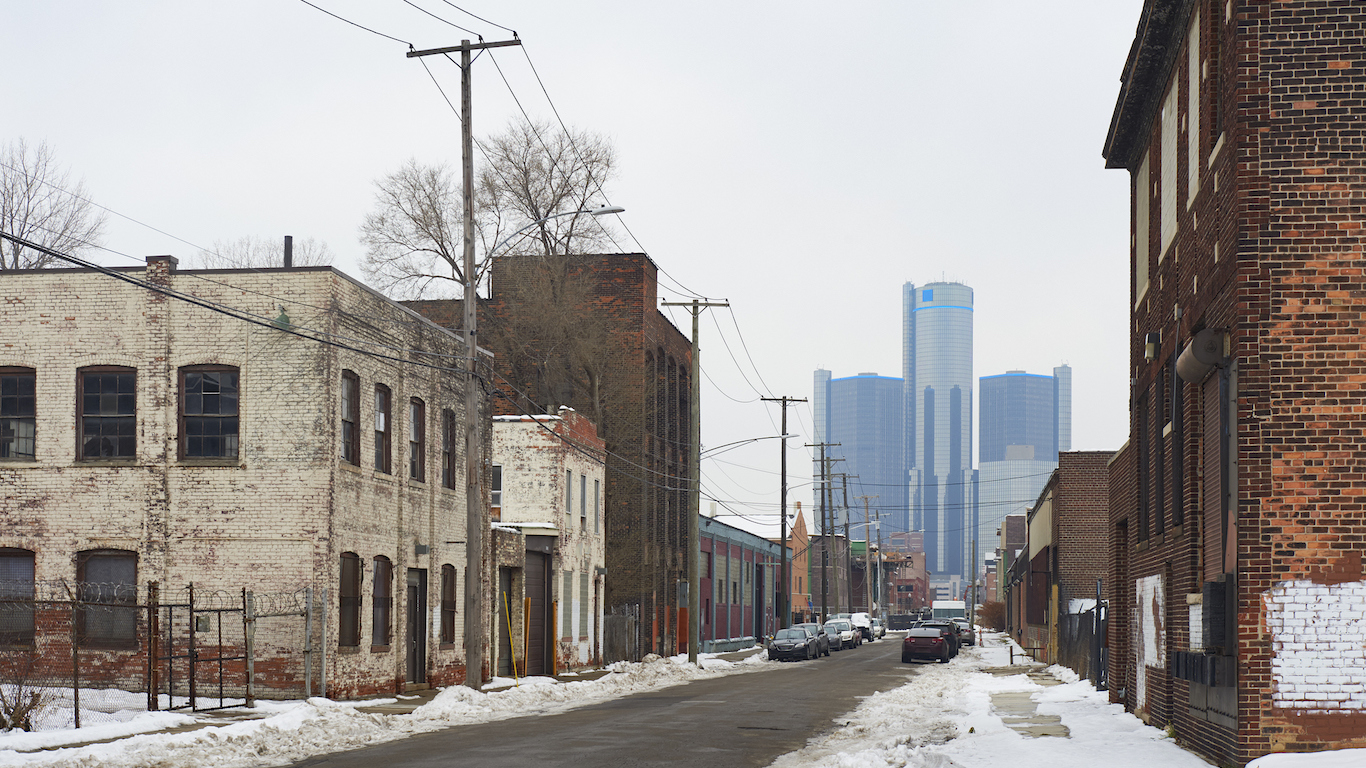
22. Michigan
> Largest industry: Hospitals and nursing and residential care facilities
> Industry GDP contribution: $17.0 billion
> Industry output as pct. of GDP: 4.0%
> Industry workforce: 908,145
Perhaps somewhat surprising, auto manufacturing is not the largest industry in Michigan. Rather, the hospitals and nursing facilities industry is. The state has many such facilities, and they have a major impact on Michigan’s economy. The state is also home to Beaumont and Spectrum Health Butterworth — two of the largest hospitals in the United States, with over 1,000 beds each. Hospitals and residential care facilities generated $17.0 billion in 2015, more than any other industry in the state.

23. Minnesota
> Largest industry: Ambulatory health care services
> Industry GDP contribution: $12.9 billion
> Industry output as pct. of GDP: 4.4%
> Industry workforce: 283,206
After real estate, ambulatory health care services is the largest industry in Minnesota. As is the case in most states, Minnesota’s largest industry contributed to outsized economic growth in 2015. Ambulatory health care services grew by 6.3% in 2015, far faster than the state economy as a whole, which expanded by only 1.3% the same year.
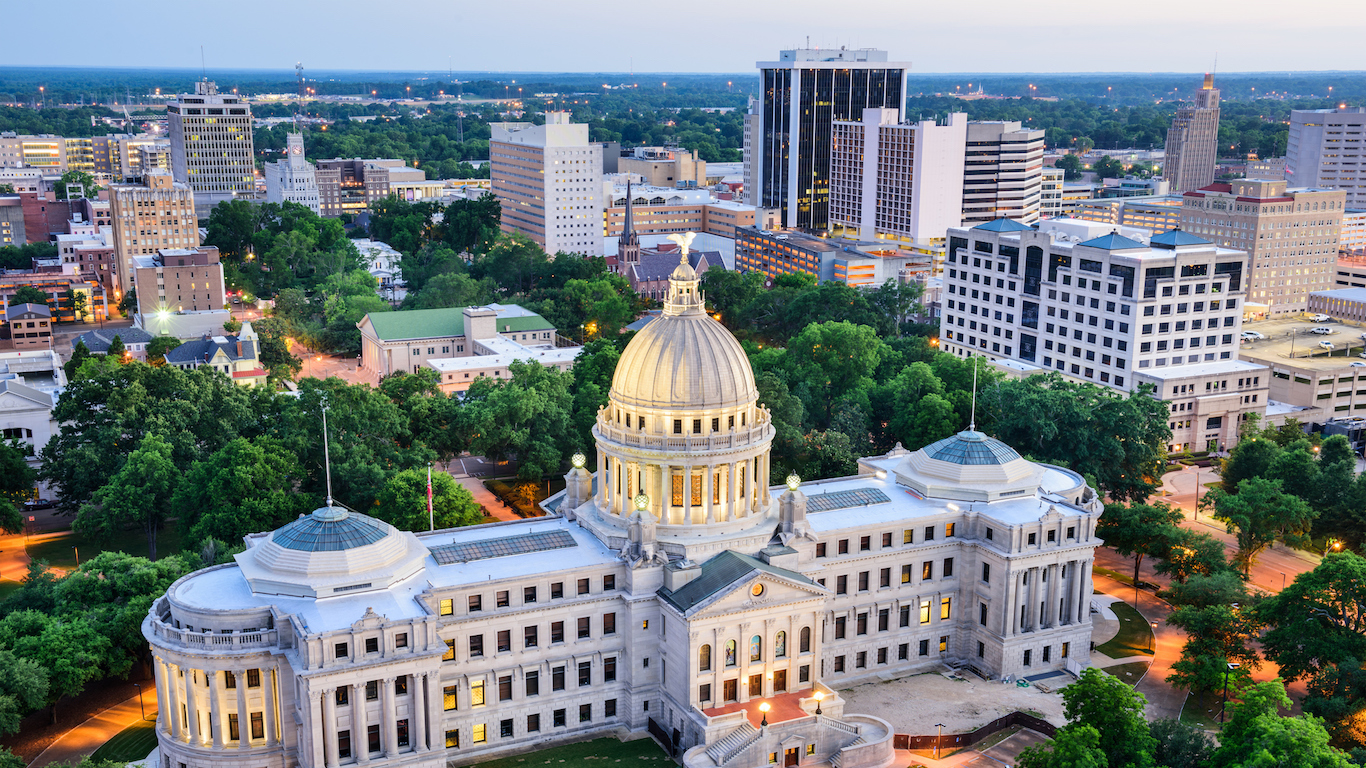
24. Mississippi
> Largest industry: Ambulatory health care services
> Industry GDP contribution: $4.0 billion
> Industry output as pct. of GDP: 4.2%
> Industry workforce: 94,102
While certain industries are highly local and depend on a state’s resources, location, and other state specific factors, other industries are needed across the country, regardless of the local economy. Ambulatory health care services, a major industry in every state, is also Mississippi’s largest. The size of the industry in the state is likely bolstered by the large share of state residents that have need for care. Nearly one in every six state residents are on disability, one of the highest shares of any state.
[in-text-ad-2]

25. Missouri
> Largest industry: Hospitals and nursing and residential care facilities
> Industry GDP contribution: $10.9 billion
> Industry output as pct. of GDP: 4.2%
> Industry workforce: 588,810
Hospitals and nursing homes employ over half a million people in Missouri and account for 4.2% of overall GDP. The state is home to Barnes-Jewish Hospital in St. Louis, one of the largest in the country with nearly 1,400 beds. As the baby boomer generation ages, health care is projected to grow far faster than most industries, and in 2015, Missouri’s hospital and nursing care industry expanded by 3.1% — more than double the state’s 1.4% overall economic growth.

26. Montana
> Largest industry: Hospitals and nursing and residential care facilities
> Industry GDP contribution: $2.0 billion
> Industry output as pct. of GDP: 4.9%
> Industry workforce: 105,027
Home to a little over a million people, Montana’s economy is one of the smallest of any state. The state’s 2015 GDP of $41.0 billion was larger than that of only three other states. Montana’s hospital and nursing home industry generated 4.9% of the state’s total GDP in 2015, more than any other industry. The elderly are more likely to require medical attention or reside in an assisted living facility, and 17.3% of Montana’s population are 65 or older, the fifth largest share of any state.
[in-text-ad]
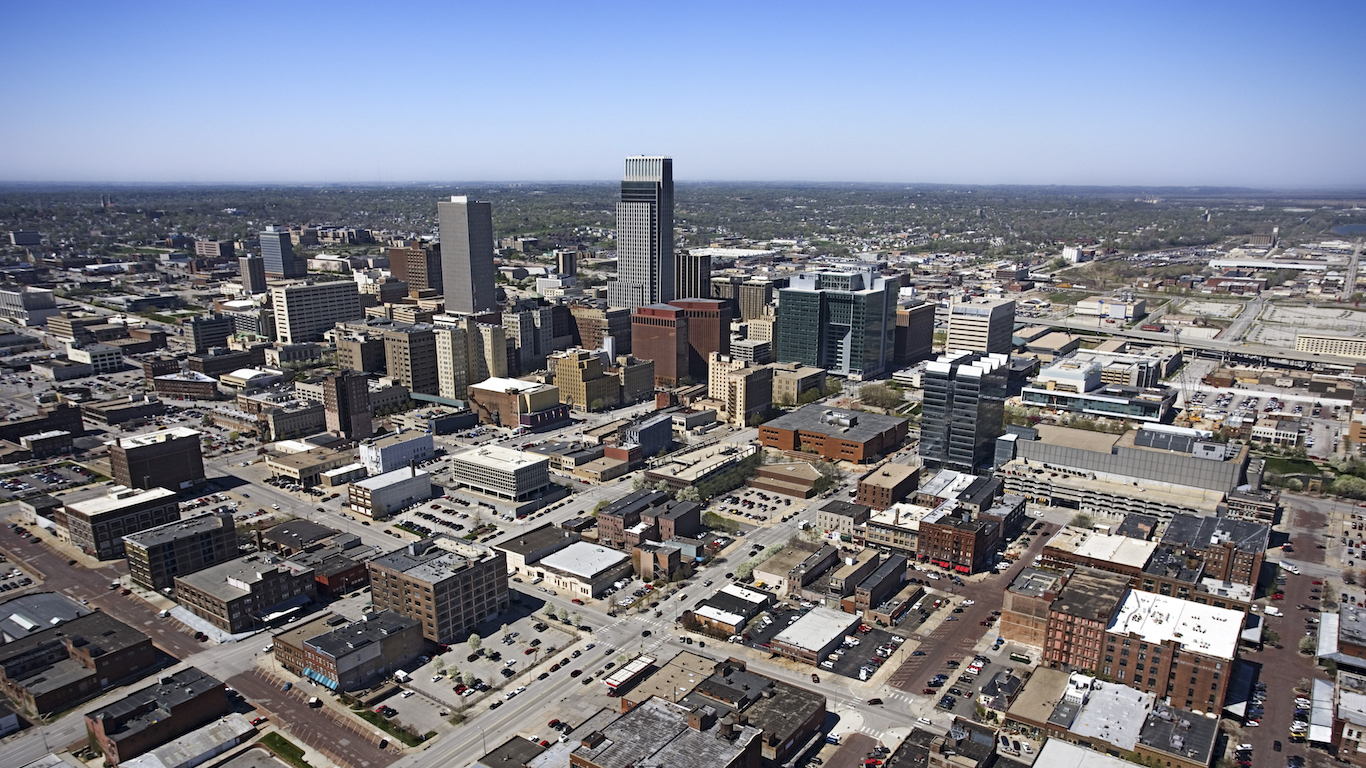
27. Nebraska
> Largest industry: Insurance
> Industry GDP contribution: $6.8 billion
> Industry output as pct. of GDP: 6.8%
> Industry workforce: 25,476
Nebraska’s insurance industry has grown in an explosive way in recent years. In 2011, the industry generated $4.2 billion in GDP. As of 2015, the industry’s contribution to the state economy had increased by over 60% to $6.8 billion. Despite being the largest industry in the state, Nebraska’s insurance workers are not compensated as well as workers in the industry nationwide. The average American insurance worker earns $81,146 annually, while the average insurance worker in Nebraska earns $64,926 annually.

28. Nevada
> Largest industry: Accommodation
> Industry GDP contribution: $13.6 billion
> Industry output as pct. of GDP: 10.8%
> Industry workforce: 390,122
Nevada is one of only seven states where a single industry accounts for more than 10% of total GDP. Due in large part to Las Vegas, Nevada’s economy is heavily dependent on tourism, and in 2015, the state’s accommodations industry generated $13.6 billion. Some 42.3 million people visited Sin City in 2015. Accommodations will likely play an increasingly larger role in the state’s economy as annual visits climbed to 42.9 million in 2016.

29. New Hampshire
> Largest industry: Insurance
> Industry GDP contribution: $3.6 billion
> Industry output as pct. of GDP: 5.3%
> Industry workforce: 14,262
In most states, the largest industry grew in 2015, contributing to state’s economic growth. New Hampshire’s insurance industry is a notable exception. While most of each state’s largest industries grew by at least 5% in 2015, New Hampshire’s contracted by 2.7%. Professionals in the state’s insurance industry tend to be are well compensated. Across the United States, the average annual salary in the industry is about $81,000. In New Hampshire, insurance workers earn over $87,000 on average.
[in-text-ad-2]
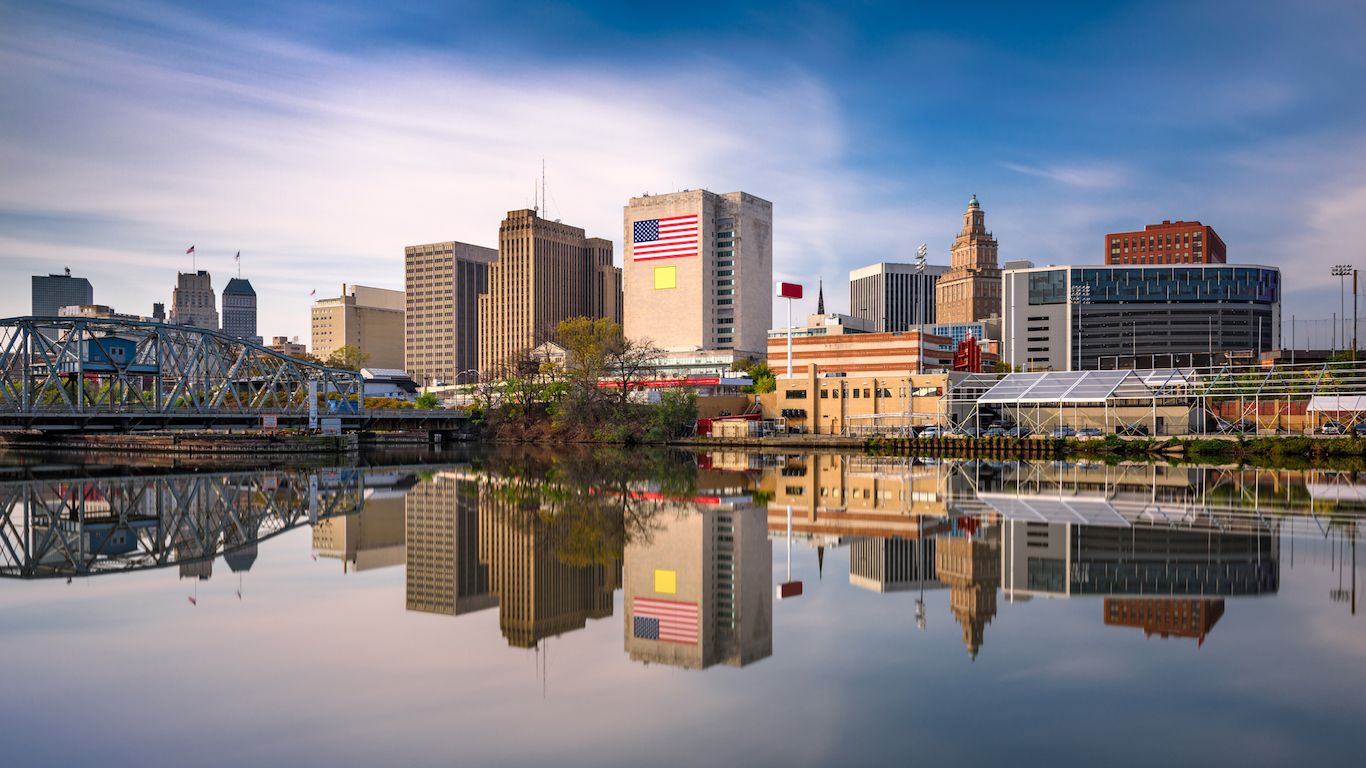
30. New Jersey
> Largest industry: Ambulatory health care services
> Industry GDP contribution: $20.9 billion
> Industry output as pct. of GDP: 4.1%
> Industry workforce: 444,514
New Jersey’s economy was eighth largest of any state in 2015, with a GDP of over half a trillion dollars. Ambulatory health care services accounted for 4.1% of the state’s total economic output that year, the most of any industry. As the baby boomer generation ages, demand for medical care is projected to rise substantially. Not surprisingly, ambulatory health care services expanded by 4.6% in the Garden State in 2015, far faster than the state’s 1.6% total GDP growth.

31. New Mexico
> Largest industry: Oil and gas extraction
> Industry GDP contribution: $7.7 billion
> Industry output as pct. of GDP: 8.9%
> Industry workforce: 5,342
Driven largely by its petroleum resources, New Mexico is the seventh largest net producer of energy among all states. Oil and gas production contributed $7.7 billion to the state economy in 2015 — or 8.9% of the state’s total GDP. Though falling oil prices have hurt the industry in recent years, economic output tied to oil and gas extraction in New Mexico expanded by about 25% in 2015.
[in-text-ad]

32. New York
> Largest industry: Federal Reserve banks and credit services
> Industry GDP contribution: $81.7 billion
> Industry output as pct. of GDP: 6.5%
> Industry workforce: 163,758
One of the 12 Federal Reserve banks located throughout the United States is in lower Manhattan. Lower Manhattan is also home to countless banking and financial institutions, and partially as a result, the Federal Reserve banks and credit intermediation sub-sector is the largest in New York state, generating $81.7 billion in economic output in 2015.
In most states, the largest industry grew in 2015, contributing to the state’s economic growth. In New York, however, the Fed and banks involved in credit intermediation were a drag on the economy, as the industry contracted by 3.4%. Still, as a whole, the state economy managed to expand by 1.2% the same year.

33. North Carolina
> Largest industry: Chemical products manufacturing
> Industry GDP contribution: $24.0 billion
> Industry output as pct. of GDP: 5.4%
> Industry workforce: 42,446
A number of major chemical and plastics companies, including giants such as BASF and the soon to be merged DuPont and Dow Chemical, operate in North Carolina. Since 2011, North Carolina’s chemical products manufacturing industry, the largest in the state, has declined by about 17%. Still, North Carolina produces nearly 8% of the total value of the nation’s chemical production in dollars.
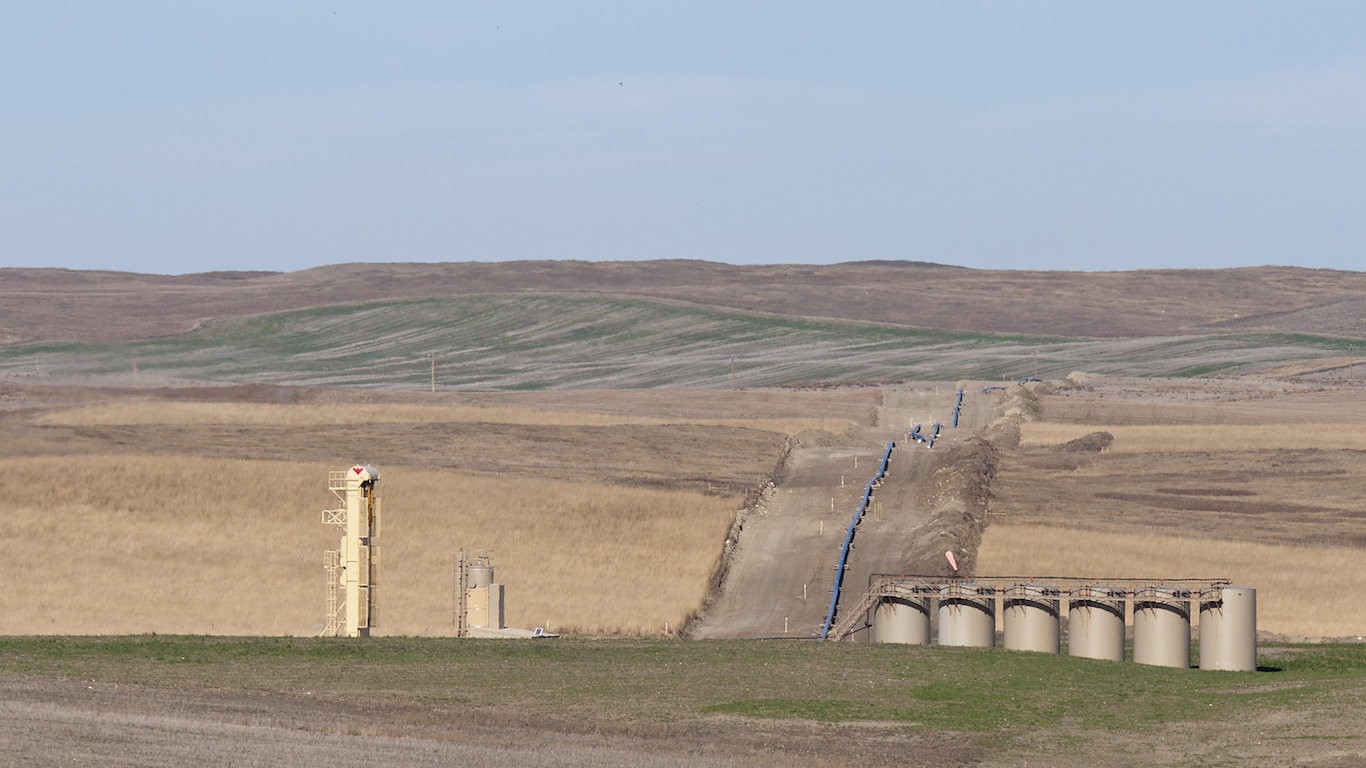
34. North Dakota
> Largest industry: Oil and gas extraction
> Industry GDP contribution: $3.8 billion
> Industry output as pct. of GDP: 7.5%
> Industry workforce: 2,906
Producing an estimated 12.5% of all crude oil in the United States in 2015, North Dakota is the second largest crude oil-producing state. Exploitation of the state’s Bakken shale formation turned North Dakota into America’s boom state practically overnight. Oil and gas extraction generated $3.8 billion in economic output in North Dakota in 2015, more than a 200% increase over the industry’s contribution five years prior.
[in-text-ad-2]

35. Ohio
> Largest industry: Hospitals and nursing and residential care facilities
> Industry GDP contribution: $22.2 billion
> Industry output as pct. of GDP: 4.1%
> Industry workforce: 1,246,122
Hospitals and residential care facilities employ over 1.2 million people in Ohio. The state’s largest industry is bolstered by the Cleveland Clinic, one of the largest hospitals in the country which boasts over 1,200 beds. Hospitals and nursing facilities in the state generated some $22.2 billion in economic output in 2015.
Ohio has a relatively diverse economy, and hospitals and nursing homes account for only 4.1% of the state’s GDP.
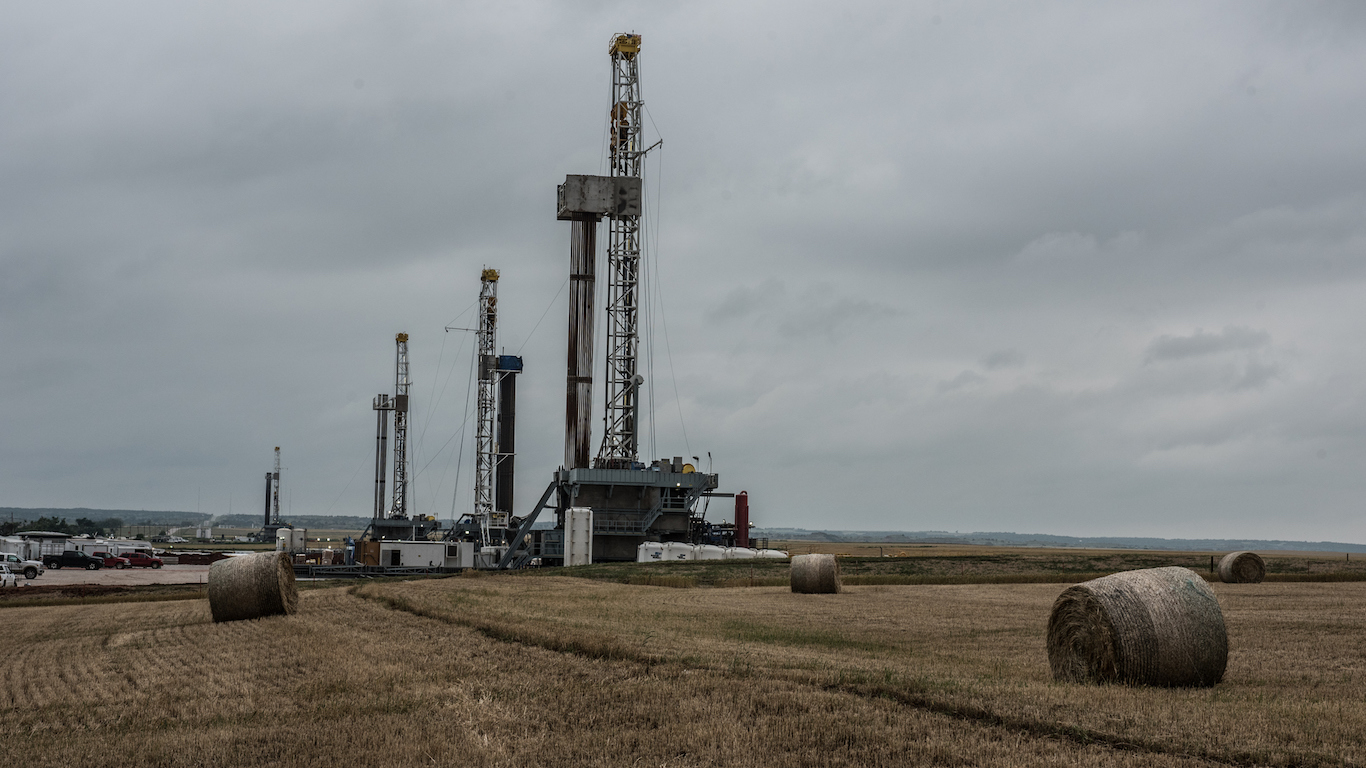
36. Oklahoma
> Largest industry: Oil and gas extraction
> Industry GDP contribution: $28.0 billion
> Industry output as pct. of GDP: 15.6%
> Industry workforce: 23,868
Oklahoma is one of only seven states where real estate is not the largest industry. Like most other states with the same distinction, Oklahoma is resource-rich and heavily dependent on oil and gas extraction. The industry accounted for 15.6% of the state’s total economic output. In comparison, the largest industry in most states accounts for less than 6.0% of total GDP. Oklahoma accounted for 7.6% of total natural gas production in the United States in 2015, and it ranks in the top five oil producing states.
[in-text-ad]

37. Oregon
> Largest industry: Computers and electronics manufacturing
> Industry GDP contribution: $34.2 billion
> Industry output as pct. of GDP: 17.1%
> Industry workforce: 37,520
Several West Coast states are known for their substantial tech sectors. Washington state is home to giants Microsoft and Amazon, while California, of course, has Silicon Valley. The neighbor of both of those states, Oregon, has a substantial tech industry of its own. Computer and electronic products manufacturing employs more than 37,000 people and generates over $34 billion annually.
Lately however, the sector has been a drag on the state’s economy. Oregon’s computer and electronics manufacturing subsector contracted by a staggering 34.2% in the last five years.

38. Pennsylvania
> Largest industry: Broadcasting and telecommunications
> Industry GDP contribution: $37.5 billion
> Industry output as pct. of GDP: 5.8%
> Industry workforce: 35,633
Pennsylvania’s broadcasting and telecommunications industry has grown rapidly in recent years. The state’s largest industry generated $37.5 billion in 2015, a 30.3% increase from only five years earlier. Industry jobs are also relatively high paying in the Keystone State. The average salary among broadcasting and telecommunications professionals is about $86,000 in Pennsylvania, or about $3,000 more than is typical nationwide.

39. Rhode Island
> Largest industry: Hospitals and nursing and residential care facilities
> Industry GDP contribution: $2.7 billion
> Industry output as pct. of GDP: 5.4%
> Industry workforce: 124,989
After real estate, hospitals and nursing homes contribute the most to Rhode Island’s economy. The industry, which provides about 125,000 jobs in the state, generated $2.7 billion in economic output in 2015.
In most states, the largest industry was an engine of economic growth in 2015, but in Rhode Island, hospitals and nursing facilities were an exception. The industry expanded by only 0.6% in 2015, roughly half Rhode Island’s 1.1% total GDP growth that year.
[in-text-ad-2]

40. South Carolina
> Largest industry: Ambulatory health care services
> Industry GDP contribution: $7.1 billion
> Industry output as pct. of GDP: 4.0%
> Industry workforce: 167,882
As health insurance coverage increases and the population ages, health care is projected to be one of the fastest growing industries in the coming years. The largest industry by economic output in South Carolina, ambulatory health care services has been a boon to the state’s economy. The industry expanded by 7.5% in 2015, driving the state’s total 2.8% GDP growth.
The elderly typically require more frequent medical checkups and doctor visits than younger people, and in South Carolina, 16.2% of the population is 65 or older, higher than the 14.9% share of the total U.S. population.
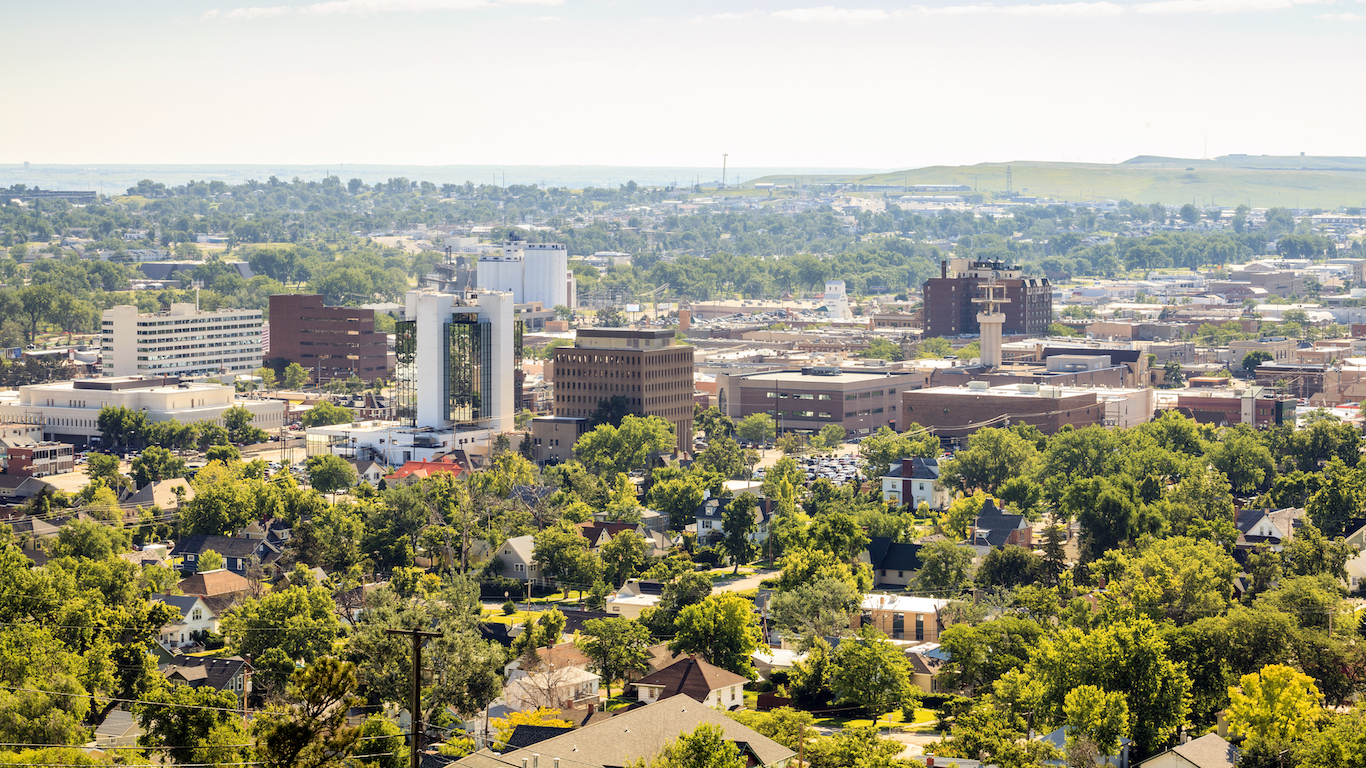
41. South Dakota
> Largest industry: Federal Reserve banks and credit services
> Industry GDP contribution: $4.1 billion
> Industry output as pct. of GDP: 9.9%
> Industry workforce: 16,969
Since South Dakota removed restrictions on interest rate and fee caps in the early 1980’s, the state’s economy changed noticeably. Multiple banking giants, including Citibank, Wells Fargo, and Capital One have all relocated their credit department headquarters to the state. A banking friendly state, South Dakota’s largest industry is now credit intermediation. The industry, which accounted for a disproportionately large 9.9% share of the state’s economy in 2015, employs about 17,000 people.
[in-text-ad]

42. Tennessee
> Largest industry: Ambulatory health care services
> Industry GDP contribution: $14.0 billion
> Industry output as pct. of GDP: 5.0%
> Industry workforce: 288,028
Some industries are more susceptible to changing consumer tastes and spending habits. However, society’s need for medical care is nearly constant, regardless of the economy. In fact, as the baby boom generation continues to age, need for outpatient care will continue to rise. The economic output of Tennessee’s ambulatory health care services, which includes clinic and doctor visits, has increased by 14.8% in the past five years. The largest industry in the state, ambulatory health care accounts for 5.0% of Tennessee’s GDP.

43. Texas
> Largest industry: Oil and gas extraction
> Industry GDP contribution: $160.4 billion
> Industry output as pct. of GDP: 10.7%
> Industry workforce: 99,353
Few states have such a dominant or iconic industry as Texas’s oil and gas industry. Home to more than a third of the country’s crude oil reserves, Texas is by far the largest petroleum and natural gas producing state in terms of GDP. Oil and gas extraction generated $160.4 billion in 2015, more than the total GDP of 21 other states. Despite a global slump in oil prices that began in late 2014, Texas’s largest industry expanded by 13.6% in 2015.

44. Utah
> Largest industry: Federal Reserve banks and credit services
> Industry GDP contribution: $6.0 billion
> Industry output as pct. of GDP: 4.6%
> Industry workforce: 34,458
Due in large part to the presence of over a dozen industrial banks, banking and credit intermediation is the largest industry in Utah. Industrial banks generally serve high net worth clients and are not subject to the same restrictions as commercial banks. Utah’s banking industry generated some $6 billion in economic output in 2015 and accounted for 4.6% of the state’s total GDP.
Though banking is an engine of economic growth in Utah, it is not an especially high paying industry. The average annual salary among industry professionals in Utah is about $62,000 — well below the $77,000 industry average salary nationwide.
[in-text-ad-2]

45. Vermont
> Largest industry: Ambulatory health care services
> Industry GDP contribution: $1.3 billion
> Industry output as pct. of GDP: 4.8%
> Industry workforce: 33,412
Depending on the size of the state economy, a state’s largest industry can generate tens of billions of dollars a year, or, in the case of very small states, it can barely generate over $1 billion. The latter is the case with Vermont, one of the least populous states in the country. The state’s largest industry, outpatient health care, contributed just $1.3 billion to state GDP. Almost every major industry in California is larger than Vermont’s largest industry. While it pales in comparison to other, much larger states, Vermont’s health care industry is big for a state of its size. This is likely due in part to the state’s relatively large elderly population, a group that often requires additional health care services.

46. Virginia
> Largest industry: Administrative and support services
> Industry GDP contribution: $15.5 billion
> Industry output as pct. of GDP: 3.6%
> Industry workforce: 432,482
Though it is Virginia’s largest industry after real estate, administrative and support services is not especially dominant in the Old Dominion state. The $15.5 billion generated by administrative and support services in 2015 accounted for only 3.6% of GDP that year — making Virginia one of only three states in which the largest industry contributed less than 4.0% to overall GDP. Still, the industry is an economic boon for Virginia, expanding by 22.6% in the last five years. In comparison, Virginia’s overall economy grew at only a 3.1% pace over the same period.
[in-text-ad]

47. Washington
> Largest industry: Publishing industries, except Internet (includes software)
> Industry GDP contribution: $28.8 billion
> Industry output as pct. of GDP: 7.2%
> Industry workforce: 61,912
Almost 1 in every 10 Americans employed in publishing work at companies in Washington state. Accounting for about 7.2% of the state’s total GDP, publishing is the largest industry in the state.
In general, publishing is a high paying industry. Nationwide, the average annual salary in the industry is about $104,000. With an average salary of about $190,000, publishing professionals are compensated even more generously in Washington. Publishing companies in Washington include software companies like Microsoft.
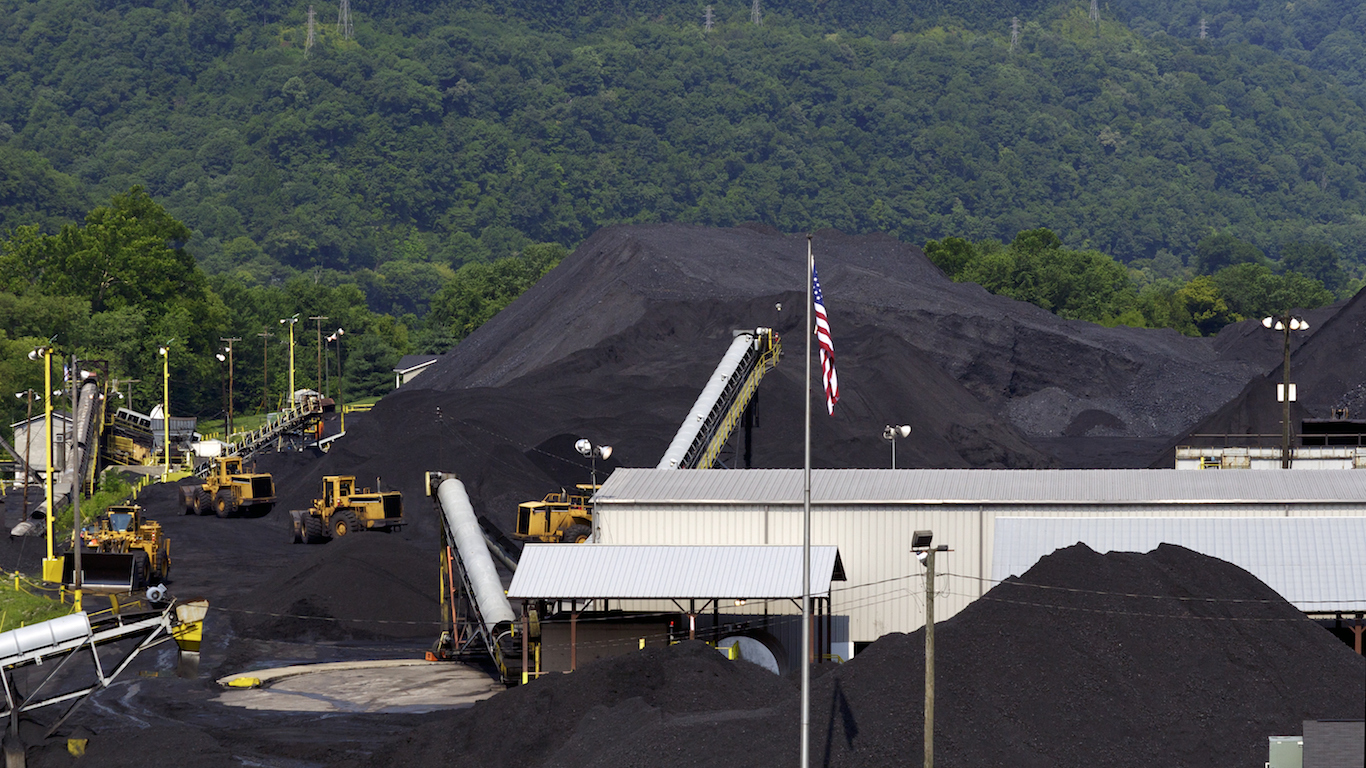
48. West Virginia
> Largest industry: Mining, except oil and gas
> Industry GDP contribution: $4.9 billion
> Industry output as pct. of GDP: 7.3%
> Industry workforce: 16,526
West Virginia is the country’s fourth largest energy-producing state, largely due to its substantial coal production. The state is the largest coal producer in the country east of the Mississippi. However, energy prices have plummeted in recent years, and this has clearly negatively affected the state’s largest industry. West Virginia’s mining industry excluding oil and gas generated just under $5 billion in 2015. That is down from over $8 billion in 2011, a nearly 40% decline.

49. Wisconsin
> Largest industry: Insurance
> Industry GDP contribution: $14.2 billion
> Industry output as pct. of GDP: 5.2%
> Industry workforce: 62,351
Generating $14.2 billion in economic output in 2015, insurance is the largest industry in Wisconsin after real estate. Partially due to rising insurance coverage rates in the state, largely attributable to the Affordable Care Act, insurance has been a boon for the state’s economy, expanding by 25.6% over the last five years. Insurance companies headquartered in the state include Sentry, American Family Insurance, and Northwestern Mutual Life Insurance.
[in-text-ad-2]

50. Wyoming
> Largest industry: Oil and gas extraction
> Industry GDP contribution: $4.5 billion
> Industry output as pct. of GDP: 12.5%
> Industry workforce: 4,253
During the worst of the recession and in the aftermath, a few of the major oil producing states were able to weather poor global economy. Unemployment rates remained relatively stable in these states. Despite the global decline in the price of oil that began in late 2014, Wyoming’s oil and gas extraction industry expanded by 14.4% in 2015 — even as the overall economy contracted by 0.3% the same year. The worst of the effects falling oil prices will have on Wyoming’s economy likely remain to be seen.
Detailed Findings and Methodology
Just as states range in size and population, regional GDP can also range widely. California’s economic output of over $2.2 trillion in 2015 is more than the total GDP of either Australia, Brazil, or Canada. Computer and electronics manufacturing, California’s largest industry, generated $93.1 billion in 2015, more than the entire economy of 14 other states.
Excluding real estate, a given state’s largest industry often reflects certain unique characteristics of that state. For example, the elderly often require more regular medical care and doctor visits than younger people, and in Florida, a destination for retired Americans, about 1 in every 5 residents are 65 and older, the largest share of any state. It is not likely a coincidence health care is Florida’s largest industry, generating some $39.3 billion in 2015.
In other cases, a state’s natural resources have a significant effect on the economic landscape. Natural resource extraction or production are the largest industries in nine resource-rich states, including Alaska, North Dakota, and Texas.
Sometimes, a state’s unique laws have attracted companies that drive economic activity. South Dakota, for example, removed restrictions on interest rate and fee caps for banks in the early 1980s. Since then, several major banks have relocated their credit department headquarters to the state. Today, credit intermediation is the largest industry in South Dakota.
While every state has an industry that is larger than the rest, very few states are dominated by a single industry. Nationwide, ambulatory health care services, the largest industry after real estate, accounts for only 3.7% of economic output. In most states, the largest industry accounts for less than 6.0% of total GDP.
The exceptions to this rule are largely energy producing states, like Alaska, where oil and gas extraction accounts for nearly 20% of total GDP.
To identify the largest industry in each state, 24/7 Wall St. reviewed each state’s industries and their respective GDP contributions from the Bureau of Economic Analysis. All BEA data is as of 2015, the most recent period for which detailed data is available. With only a few exceptions, the largest industry in each state is real estate. In order to identify regional industrial differences, we excluded the real estate sector in our examination. All government sectors were also excluded. Only industries on the same subsector level were included, and as a result, broader categories such as manufacturing, construction and retail were not considered. Employment and wage figures for private employees in each industry came from the Quarterly Census of Employment and Wages. The QCEW and BEA industry data were aligned according to their North American Industry Classification System codes. Median age and share of the population 65 and older are from the U.S. Census Bureau’s American Community Survey and are for 2015. Economic output and GDP are used interchangeably regarding industry contribution.
Retirement planning doesn’t have to feel overwhelming. The key is finding expert guidance—and SmartAsset’s simple quiz makes it easier than ever for you to connect with a vetted financial advisor.
Here’s how it works:
Why wait? Start building the retirement you’ve always dreamed of. Click here to get started today!
Thank you for reading! Have some feedback for us?
Contact the 24/7 Wall St. editorial team.